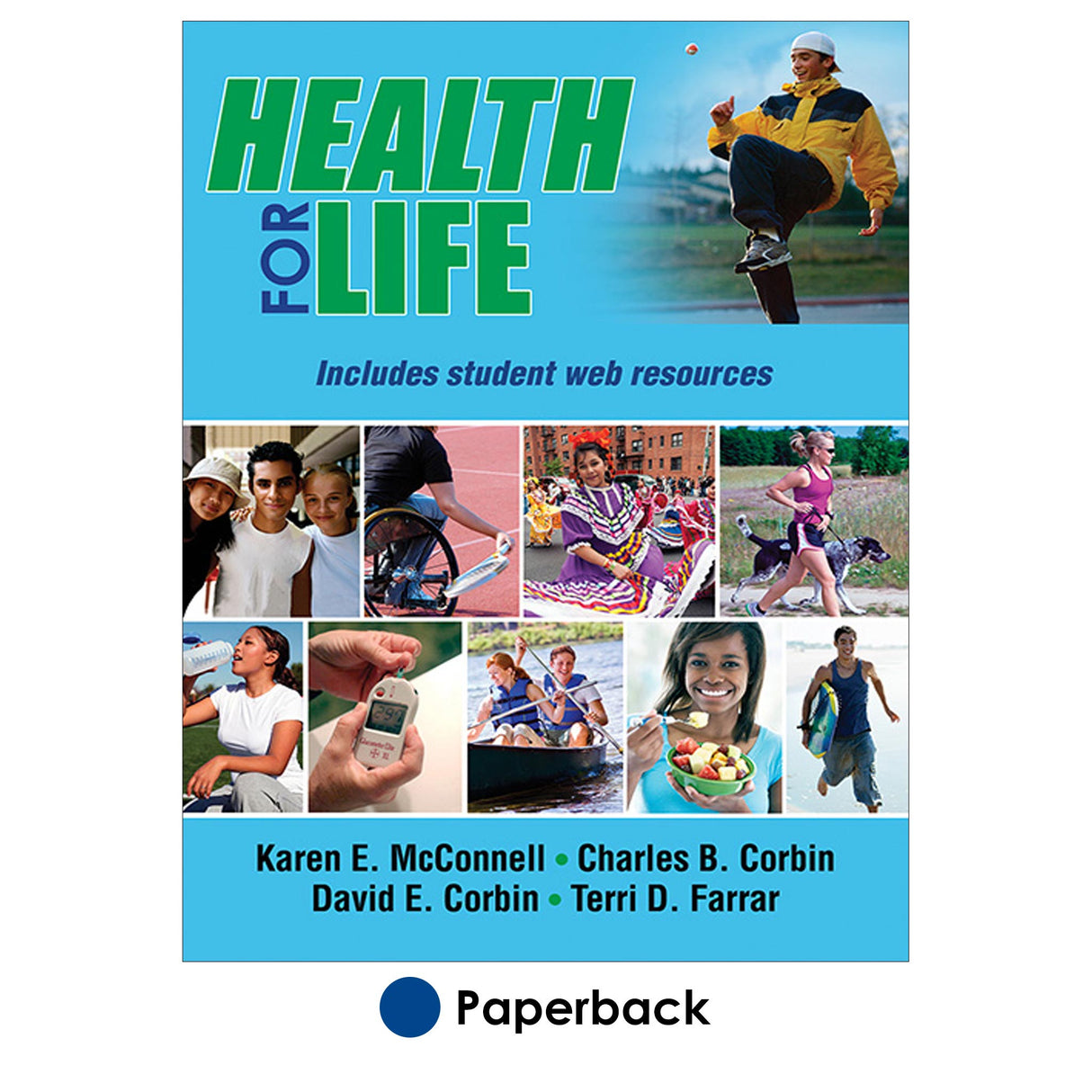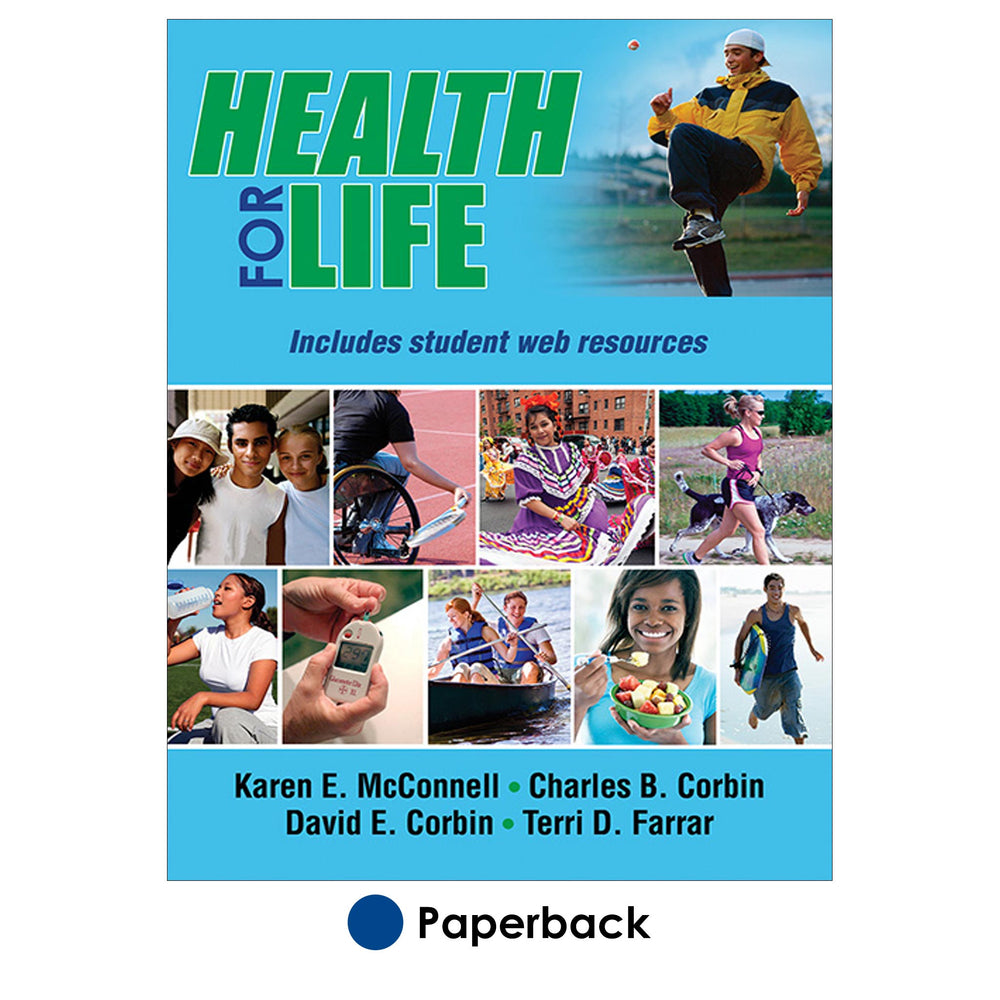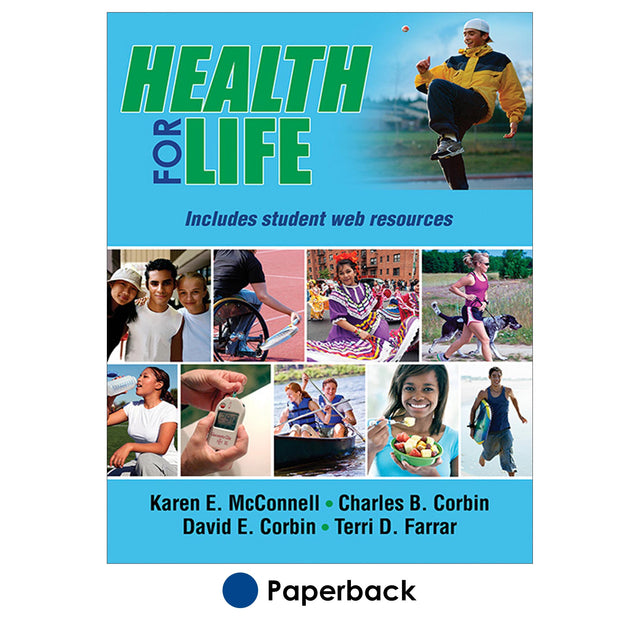Health for Life With Web Resources-Paper
$52.00 USD
Health for Life provides the keys necessary for adopting healthy habits and committing to healthy living in high school and throughout the life span. The text covers all of the components of personal well-being, including physical, mental, emotional, social, and spiritual health. It provides students the knowledge in making healthy choices and fosters the skill development required for taking healthy actions.
Health for Life helps students in these ways:
- Analyze how key influences affect their health and wellness, such as family, peers, media, and technology
- Explore consumer topics and use appropriate resources to find answers to challenging questions
- Sharpen their interpersonal communication skills as they share health knowledge; debate controversial topics; demonstrate refusal, negotiation, and refusal skills; manage interpersonal conflicts; and promote healthy living among their peers
- Use decision-making skills and apply healthy living skills as they identify solutions to problems posed
- Evaluate their own health habits as they relate to a variety of behaviors
- Create goals for behavior change and establish plans for healthy living
- Communicate health information with family and advocate for healthy living at home and in their communities
- Discover how health and technology intersect on various topics
The text is divided into seven units of 20 chapters. The chapters help students explore a range of topics, including mental health, nutrition, physical activity, stress management, healthy relationships, avoiding destructive habits, and making good health choices throughout life.
Health for Life has an abundance of features that help students connect with content in personal ways and retain the information. Here’s a glance at some of those features:
- Lesson Objectives, Lesson Vocabulary, Comprehension Check, and Chapter Review help students prepare to dive in to the material, understand it, and retain it (standard NHES 1).
- Connect spurs students to analyze various influences on their health and wellness (standard NHES 2).
- Consumer Corner aids students in exploring consumer health issues (standard NHES 3).
- Healthy Communication gets students to use and expand their interpersonal communication skills as they share their views about various health topics (standard NHES 4).
- Skills for Healthy Living and Making Healthy Decisions help students learn and practice self-management so they can make wise choices related to their health and wellness (standard NHES 5).
- Planning for Healthy Living assists students in applying what they’ve learned as they set goals and establish plans for behavior change (standard NHES 6).
- Self-Assessment offers students the opportunity to evaluate their health habits and monitor improvement in health behaviors (standard NHES 7).
- Take It Home and Advocacy in Action prepare students to advocate for health at home and in their communities (standard NHES 8).
- Health Science and Health Technology focus on the roles of science and technology as they rellate to health and where science and technology intersect regarding health issues.
- Living Well News challenges students to integrate health literacy, math, and language skills to better understand a current health issue.
In addition, Health for Life is reinforced by its online resources for teachers and students. Following are highlights of these two invaluable resources.
Teacher Web Resource
The Teacher Web Resource contains the following:
- Complete lesson plans; the first three lessons have a corresponding PowerPoint slide show
- An answer key to all worksheets and quizzes
- A test package that includes tests for each chapter; tests consist of multiple-choice, true-or-false, fill-in-the-blank, and short essay questions
All lesson plans and assessments support identified learning objectives. Each lesson plan includes these features:
- Preparing the Lesson (lesson objectives and preparation)
- Bell Ringer (a journal question for students, or a quiz or activity to begin class)
- Lesson Focus (main points of the lesson paired with a student worksheet)
- Lesson Application (main activity paired with a worksheet)
- Reflection and Summary (lesson review)
- Evaluate (student quiz or test or worksheet review)
- Reinforcing the Lesson (Take It Home and Challenge activities)
Student Web Resource
The Student Web Resource contains these features:
- All worksheets, quizzes, and other materials referred to in the lesson plans
- Vocabulary flip cards and other interactive elements from the iBook edition
- Expanded discussion of selected topics that are marked by web icons in the text
- Review questions from the text, presented in an interactive format for students to fill out to check their level of understanding
Delivering the content that will help students value and adopt healthy lifestyles, and loaded with the features and online resources that will help students understand and retain the content, Health for Life promises to be one of the most crucial texts for students today.
Audience
Primary text for high school students in health courses.
Unit I. Understanding Health and Wellness
Chapter 1. Introduction to Health and Wellness
Chapter 2. Health Behavior Change and Personal Health
Chapter 3. Choosing Healthy Lifestyles
Unit II. Preventing Disease and Seeking Care
Chapter 4. Understanding Your Body
Chapter 5. Diseases and Disability
Chapter 6. Emotional Health and Wellness
Chapter 7. Health Care Consumerism
Unit III. Embracing Priority Lifestyles
Chapter 8. Nutrition: Foundations for Healthy Eating
Chapter 9. Nutrition: Energy Balance and Consumer Nutrition
Chapter 10. Physical Activity: Health and Fitness Basics
Chapter 11. Physical Activity: Getting Started With Your Plan
Chapter 12. Stress Management
Unit IV. Building Relationships and Lifelong Health
Chapter 13. Healthy Relationships and Family Living
Chapter 14. Reproductive and Sexual Health
Chapter 15. Health and Wellness Throughout Life
Unit V. Avoiding Destructive Habits
Chapter 16. Tobacco
Chapter 17. Alcohol
Chapter 18. Drugs and Medicine
Unit VI. Creating Healthy and Safe Communities
Chapter 19. Safety and First Aid
Chapter 20. A Healthy Environment
Chapter 21. Community and Public Health
Common chronic diseases and what you can do now to avoid them
Stages of Health Behavior
Health for Life offers students and teachers an array of supporting materials at www.HealthForLifeTextbook.org. In addition, Health for Life is available in digital as well as print formats. Students and teachers can use e-books in a variety of platforms, in combination with the student and teacher web resources, to interact with the material. The Health for Life iBooks Interactive Version is also available for students.
The Teacher Web Resource contains the following:
- Complete lesson plans; the first three lessons have a corresponding PowerPoint slide show
- An answer key to all worksheets and quizzes
- A test package that includes tests for each chapter; tests consist of multiple-choice, true-or-false, fill-in-the-blank, and short essay questions
- Preparing the Lesson (lesson objectives and preparation)
- Bell Ringer (a journal question for students, or a quiz or activity to begin class)
- Lesson Focus (main points of the lesson paired with a student worksheet)
- Lesson Application (main activity paired with a worksheet)
- Reflection and Summary (lesson review)
- Evaluate (student quiz or test or worksheet review)
- Reinforcing the Lesson (Take It Home and Challenge activities)
- All worksheets, quizzes, and other materials referred to in the lesson plans
- Vocabulary flip cards and other interactive elements from the iBook edition
- Expanded discussion of selected topics that are marked by web icons in the text
- Review questions from thetext, presented in an interactive format for students to fill out to checktheir level of understanding





